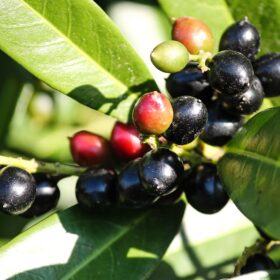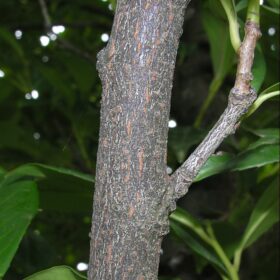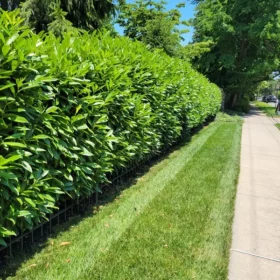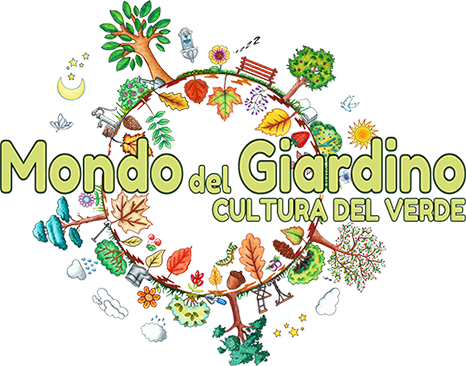IDENTIFICATION of Prunus laurocerasus
Scientific name: Prunus laurocerasus

Italian common name: Lauroceraso, Lauro regio, Lauro imperial. Cherry laurel.
Family: Rosaceae
Origin: originally from Asia Minor and Eastern Europe and was imported into Italy during the 16th century.
Evergreen or deciduous: Evergreen
VEGETABLE RECOGNITION of Prunus laurocerasus
Height: 7 – 10 m

Width (extension): 7 m
Habit: Tree of medium height but often grown as a hedge
Leaf: The leaves are dark green, much lighter and shinier when young; of a beautiful dark green on the upper page, on the underside they are pale green. Elliptical and lanceolate, they have a toothed margin. Up to 20 cm long and 6 cm wide coriaceous; oblong in shape, and rounded towards the apex; slightly serrated outwards.
Flower: The flowers are white and star-shaped; they are gathered in a sort of erect panicles up to 12 cm long. They flower in spring but a second autumn flowering is not uncommon.
Flowering: April – June
Fruit: berried, round and 1.2 cm wide. First green, then red and black when ripe. Fruits in late summer-early autumn.

Perfume: yes but acid
Toxicity: poisonous plant in all its parts because they contain hydrogen cyanide.
NEED
Maintenance: It has no particular needs.
Fertilization: It is advisable to administer a manure-based fertilizer once a year, preferably in autumn. Both the foot of the plant and the surrounding area must be covered, avoiding touching the trunk. In spring it is possible to add a little granular fertilizer for green plants.
Finally, in summer, it is advisable to fertilize using organic fertilizers based on urea.
In the first phase of cultivation, prefer a nitrogen-based fertilizer to promote good plant growth and ensure vegetative development.

Exposure to light: sun, partial shade (It prefers a sunny area for at least part of the day)
Soil type: Neutral, moist soil. Calcareous or too compact and clayey soils are absolutely to be avoided.
Soil acidity: PH not higher than 7.5
Italian climatic area: tolerates well down to -20° up to high temperatures and an altitude not exceeding 300 meters (ideal) or 700 meters (actual).
Need for water: Rains are sufficient for adult specimens except in the case of particularly dry periods where it is necessary to intervene with irrigation.
Diseases: rather resistant to diseases, the cochineal which also ruins the branches, the fungi which devour the wood of the branches, and the afids which cause the curling and crumpling of the affected leaves.

Another important enemy is the perforating powdery mildew, a fungus that mainly affects young leaves: initially, these are covered with a whitish patina and then come to necrotize with the consequent formation of cuts and perforations. Faced with this problem, it is advisable to cut and burn all the affected parts and, in the spring, especially in very humid areas with a strong temperature range, often spread wettable sulfur or special antioidic products.
Also pay attention to exposure: in summer, excessive exposure to direct sunlight can cause burns on the leaves which appear as brown or bronze spots.
Pruning: In the case of cherry laurel that forms a hedge, pruning should be done twice a year, preferably at the beginning of June and at the end of September.
It is advisable to use shears instead of the hedge trimmer as the latter could badly cut the large leaves.
For plants grown in pots, simply remove any dry or damaged twigs.
Propagation: In nature, the plant is disseminated thanks to animals, especially blackbirds and starlings which, feeding on its fruits, expel the seeds far from the place of origin.
PARTICULARITY
The name derives from the resemblance of the fruits to cherries (Prunus cerasus) and the leaves to laurel (laurel)
It is liked by bees who collect the liquid secreted at the base of the leaves and the nectar and pollen of the flowers.
Annotations

Prunus laurocerasus is used as an ornamental plant and as a barrier (hedge) thanks to its thick foliage.
Therapeutic use:
The distillate, cherry laurel water, was used in the past as a cough suppressant.
Today, due to the cyanogenic glucosides contained within it, its use in this sense is prohibited. For the same reason, the use of cherry laurel has also been prohibited in the cosmetic field.
In the kitchen:It is not used.
How to recognize the laurel from the cherry laurel? Smell the leaves. The laurel will be recognized immediately by its unmistakable scent.
For you and your animals, be careful not to ingest the cherry laurel leaves!
Now on horseback! Work awaits us! Our new wonderful outdoor space is about to be born!
GOOD WORK and…if you have any questions, write to info@ilmondodelgiardino.com
Sources of the images: thanks to Pixabay and in particular to Manuela for the photo of the gate, Solfaroli Renzo for the flowers, Christine Pfister for the leaf, Manfred Richter for the fruits and for the image of the social networks, plants.ces.ncsu.edu for habit, actaplantarum.org for the trunk, brandywinetrees.com for the hedge.



